Study of Near-Cup Droplet Breakup of an Automotive Electrostatic Rotary Bell (ESRB) Atomizer Using High-Speed Shadowgraph Imaging
Abstract
:1. Introduction
2. Materials and Methods
2.1. Experimental Setup
2.2. Image Processing
2.3. Size Measurements
2.4. Velocity Measurements
3. Results and Discussion
3.1. Ligament Breakup Observations
3.2. Size Statistics
3.3. Velocity Statistics
4. Conclusions
Author Contributions
Funding
Acknowledgments
Conflicts of Interest
References
- Khan, M.K.I.; Schutyser, M.A.I.; Schroën, K.; Boom, R. The potential of electrospraying for hydrophobic film coating on foods. J. Food Eng. 2012, 108, 410–416. [Google Scholar] [CrossRef]
- Craig, I.P.; Hewitt, A.; Terry, H. Rotary atomiser design requirements for optimum pesticide application efficiency. Crop Prot. 2014, 66, 34–39. [Google Scholar] [CrossRef]
- Akafuah, N.; Poozesh, S.; Salaimeh, A.; Patrick, G.; Lawler, K.; Saito, K. Evolution of the automotive body coating process—A Review. Coatings 2016, 6, 24. [Google Scholar] [CrossRef]
- Domnick, J.; Thieme, M. Atomization characteristics of high-speed rotary bell atomizers. At. Sprays 2006, 16, 857–874. [Google Scholar]
- Poozesh, S.; Akafuah, N.; Saito, K. Effects of automotive paint spray technology on the paint transfer efficiency—A review. Proc. Inst. Mech. Eng. Part D J. Automob. Eng. 2017, 232, 282–301. [Google Scholar] [CrossRef]
- Im, K.S.; Lai, M.C.; Yi, L.; Sankagiri, N.; Loch, T.; Nivi, H. Visualization and measurement of automotive electrostatic rotary-bell paint spray transfer processes. J. Fluids Eng. 2001, 123, 237–245. [Google Scholar] [CrossRef]
- Bailey, A.G. Electrostatic atomization of liquids. Sci. Prog. Oxf. 1974, 61, 555–585. [Google Scholar]
- Balachandran, W.; Bailey, A.G. The dispersion of liquids using centrifugal and electrostatic forces. IEEE Trans. Ind. Appl. 1984, IA-20, 682–686. [Google Scholar] [CrossRef]
- Frost, A.R. Rotary atomization in the ligament formation mode. J. Agric. Eng. Res. 1981, 26, 63–78. [Google Scholar] [CrossRef]
- Corbeels, P.L.; Senser, D.W.; Lefebvre, A.H. Atomization characteristics of a highspeed rotary-bell paint applicator. At. Sprays 1992, 2, 87–99. [Google Scholar] [CrossRef]
- Debler, W.; Yu, D. The break-up of laminar liquid jets. Proc. R. Soc. Lond. A Math. Phys. Sci. 1988, 415, 107–119. [Google Scholar] [CrossRef]
- Ellwood, K.R.J. Laminar jets of Bingham-plastic liquids. J. Rheol. 1990, 34, 787–812. [Google Scholar] [CrossRef]
- Marmottant, P.; Villermaux, E. Fragmentaion of stretched liquid ligaments. Phys. Fluids 2004, 16, 2732–2741. [Google Scholar] [CrossRef]
- Bizjan, B.; Širok, B.; Hočevar, M.; Orbanić, A. Liquid ligament formation dynamics on a spinning wheel. Chem. Eng. Sci. 2014, 119, 187–198. [Google Scholar] [CrossRef]
- Ahmed, M.; Youssef, M.S. Characteristics of mean droplet size produced by spinning disk atomizers. J. Fluids Eng. 2012, 134, 71103. [Google Scholar] [CrossRef]
- Peng, H.; Wang, N.; Wang, D.; Ling, X. Experimental study on the critical characteristics of liquid atomization by a spinning disk. Ind. Eng. Chem. Res. 2016, 55, 6175–6185. [Google Scholar] [CrossRef]
- Bizjan, B.; Širok, B.; Hočevar, M.; Orbanić, A. Ligament-type liquid disintegration by a spinning wheel. Chem. Eng. Sci. 2014, 116, 172–182. [Google Scholar] [CrossRef]
- Senuma, Y.; Hilborn, J.G. High speed imaging of drop formation from low viscosity liquids and polymer melts in spinning disk atomization. Polym. Eng. Sci. 2002, 42, 969–982. [Google Scholar] [CrossRef]
- Kim, T.S.; Kim, M.U. The flow and hydrodynamic stability of a liquid film on a rotating disc. Fluid Dyn. Res. 2009, 41, 035504. [Google Scholar] [CrossRef]
- Ahmed, M.; Youssef, M.S. Influence of spinning cup and disk atomizer configurations on droplet size and velocity characteristics. Chem. Eng. Sci. 2014, 107, 149–157. [Google Scholar] [CrossRef]
- Huang, H.; Lai, M.-C.; Meredith, W. Simulation of spray transport from rotary cup atomizer using KIVA-3V. In Proceedings of the ICLASS’00, Pasadena, CA, USA, 16–20 July 2000; pp. 1435–1437. [Google Scholar]
- Dombrowski, N.; Lloyd, T.L. Atomisation of liquids by spinning cups. Chem. Eng. J. 1974, 8, 63–81. [Google Scholar] [CrossRef]
- Ellwood, K.R.J.; Tardiff, J.L.; Alaie, S.M. A Simplified analysis method for correlating rotary atomizer performance on droplet size and coating appearance. J. Coat. Technol. Res. 2014, 11, 303–309. [Google Scholar] [CrossRef]
- Blaisot, J.B.; Yon, J. Droplet size and morphology characterization for dense sprays by image processing: Application to the diesel spray. Exp. Fluids 2005, 39, 977–994. [Google Scholar] [CrossRef]
- MacIan, V.; Payri, R.; Garcia, A.; Bardi, M. Experimental evaluation of the best approach for diesel spray images segmentation. Exp. Tech. 2012, 36, 26–34. [Google Scholar] [CrossRef]
- Ma, Y.J.; Huang, R.H.; Deng, P.; Huang, S. the development and application of an automatic boundary segmentation methodology to evaluate the vaporizing characteristics of diesel spray under engine-like conditions. Meas. Sci. Technol. 2015, 26, 45004. [Google Scholar] [CrossRef]
- Cao, Z.M.; Nishino, K.; Mizuno, S.; Torii, K. PIV Measurement of internal structure of diesel fuel spray. Exp. Fluids 2000, 29, S211–S219. [Google Scholar] [CrossRef]
- Hess, C.F.; L’Esperance, D. Droplet Imaging Velocimeter and Sizer: A Two-dimensional technique to measure droplet size. Exp. Fluids 2009, 47, 171–182. [Google Scholar] [CrossRef]
- Zhang, M.; Xu, M.; Hung, D.L.S. Simultaneous two-phase flow measurement of spray mixing process by means of high-speed two-color PIV. Meas. Sci. Technol. 2014, 25, 95204. [Google Scholar] [CrossRef]
- Stevenin, C.; Tomas, S.; Vallet, A.; Amielh, M.; Anselmet, F. Flow characteristics of a large-size pressure-atomized spray using DTV. Int. J. Multiph. Flow 2016, 84, 264–278. [Google Scholar] [CrossRef]
- Ryan, S.D.; Gerber, A.G.; Holloway, A.G.L.; Brunswick, N. A computational study of sprays produced by rotary cage atomizers. Trans. ASABE 2012, 55, 1133–1148. [Google Scholar] [CrossRef]
- Soumendra, B.K.; Zhou, J.; Harding, A.; Williams, C.; Moncier, J.; Baker, L.; McCreight, K. Effect of atomization and rheology control additives on particle size and appearance of automotive coatings. In Proceedings of the 15th International Coating Science and Technology Symposium, St. Paul, MN, USA, 13–15 September 2010. [Google Scholar]
- Goldsworthy, L.C.; Bong, C.; Brandner, P.A. Measurements of diesel spray dynamics and the influence of fuel viscosity using PIV and shadowgraphy. At. Sprays 2011, 21, 167–178. [Google Scholar] [CrossRef]
- Ogasawara, S.; Daikoku, M.; Shirota, M.; Inamura, T.; Saito, Y.; Yasumura, K.; Shoji, M.; Aoki, H.; Miura, T. Liquid atomization using a rotary bell cup atomizer (influence of flow characteristics of liquid on breakup pattern). J. Fluid Sci. Technol. 2010, 5, 464–474. [Google Scholar] [CrossRef]
- Hatayama, Y.; Haneda, T.; Shirota, M.; Inamura, T.; Daikoku, M.; Soma, T.; Saito, Y.; Aoki, H. Formation and breakup of ligaments from a high speed rotary bell cup atomizer (Part 1: Observation and quantitative evaluation of formation and breakup of ligaments). Trans. Jpn. Soc. Mech. Eng. Ser. B 2013, 79, 1081–1094. [Google Scholar] [CrossRef]
- Majithia, A.K.; Hall, S.; Harper, L.; Bowen, P.J. Droplet breakup quantification and processes in constant and pulsed air flows. In Proceedings of the European Conference on Liquid Atomization and Spray Systems, Como Lake, Italy, 8–10 September 2008; pp. 8–10. [Google Scholar]
- Stevenin, C.; Béreaux, Y.; Charmeau, J.-Y.; Balcaen, J. Shaping air flow characteristics of a high-speed rotary-bell sprayer for automotive painting processes. J. Fluids Eng. 2015, 137, 111304. [Google Scholar] [CrossRef]
- Domnick, J.; Scheibe, A.; Ye, Q. The simulation of electrostatic spray painting process with high-speed rotary bell atomizers. Part II: External charging. Part. Part. Syst. Charact. 2006, 23, 408–416. [Google Scholar] [CrossRef]
- Gonzalez, R.C.; Woods, R.E. Digital Image Processing, 2nd ed.; Prentice Hall: Englewood Cliffs, NJ, USA, 2002. [Google Scholar]
- Rao, D.C.K.; Karmakar, S.; Basu, S. Atomization characteristics and instabilities in the combustion of multi-component fuel droplets with high volatility differential. Sci. Rep. 2017, 7, 8925. [Google Scholar] [CrossRef] [PubMed]
- Jain, M.; Prakash, R.S.; Tomar, G.; Ravikrishna, R.V. Secondary breakup of a drop at moderate weber numbers. Proc. R. Soc. A Math. Phys. Eng. Sci. 2015, 471, 20140930. [Google Scholar] [CrossRef]
- Zhao, H.; Liu, H.F.; Li, W.F.; Xu, J.L. Morphological classification of low viscosity drop bag breakup in a continuous air jet stream. Phys. Fluids 2010, 22, 114103. [Google Scholar] [CrossRef]
- Cao, X.K.; Sun, Z.G.; Li, W.F.; Liu, H.F.; Yu, Z.H. A new breakup regime of liquid drops identified in a continuous and uniform air jet flow. Phys. Fluids 2007, 19, 057103. [Google Scholar] [CrossRef]
- Ye, Q.; Domnick, J. Analysis of droplet impingement of different atomizers used in spray coating processes. J. Coat. Technol. Res. 2017, 14, 467–476. [Google Scholar] [CrossRef]
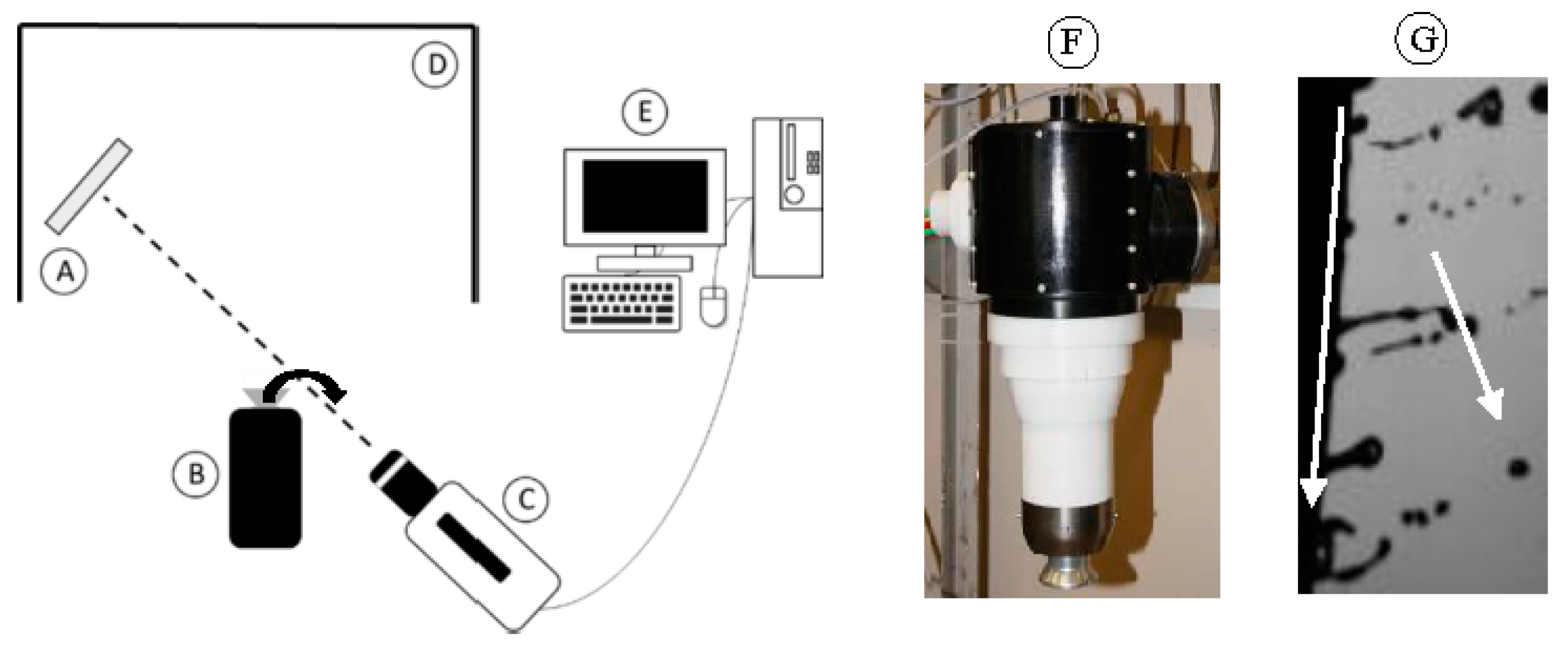

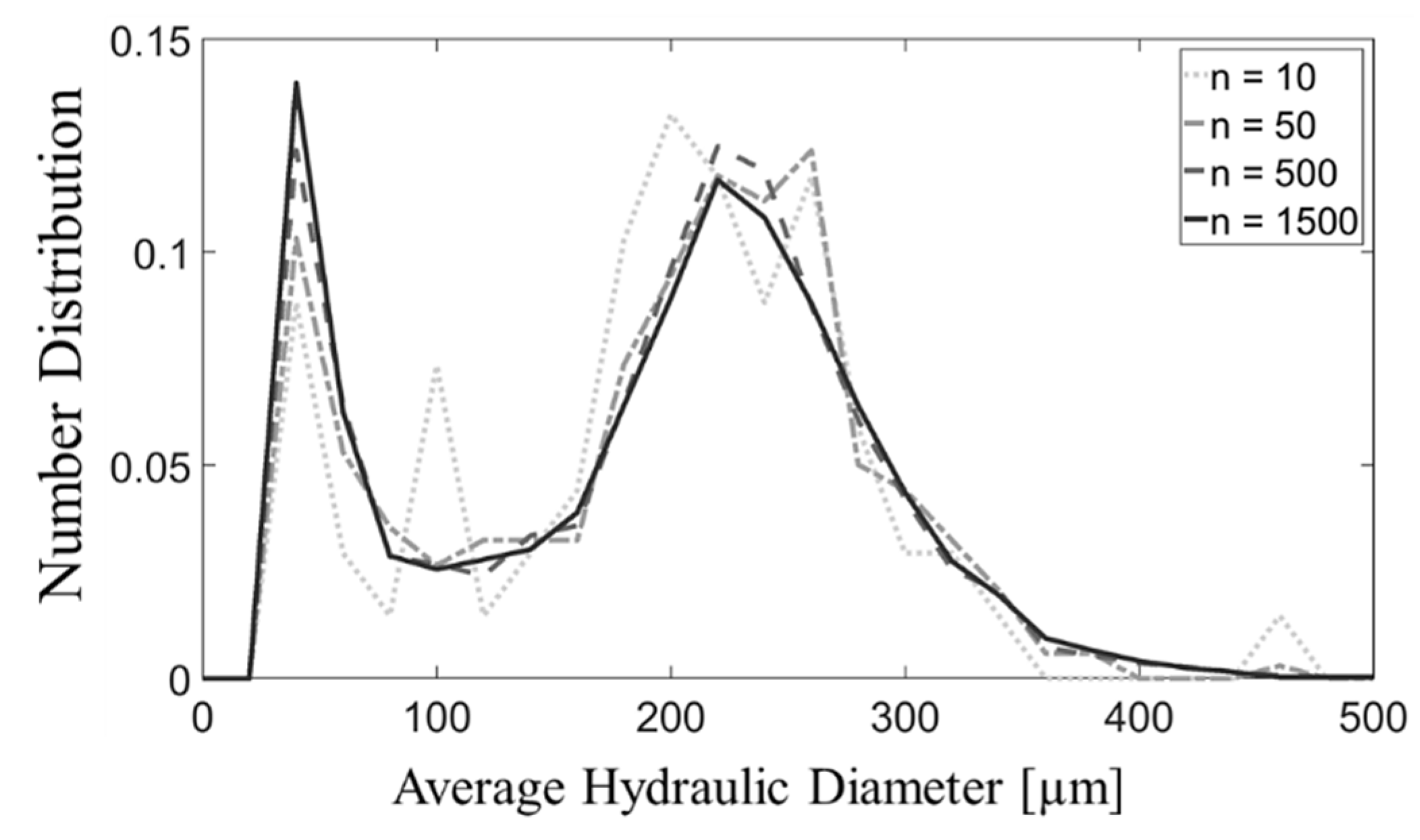
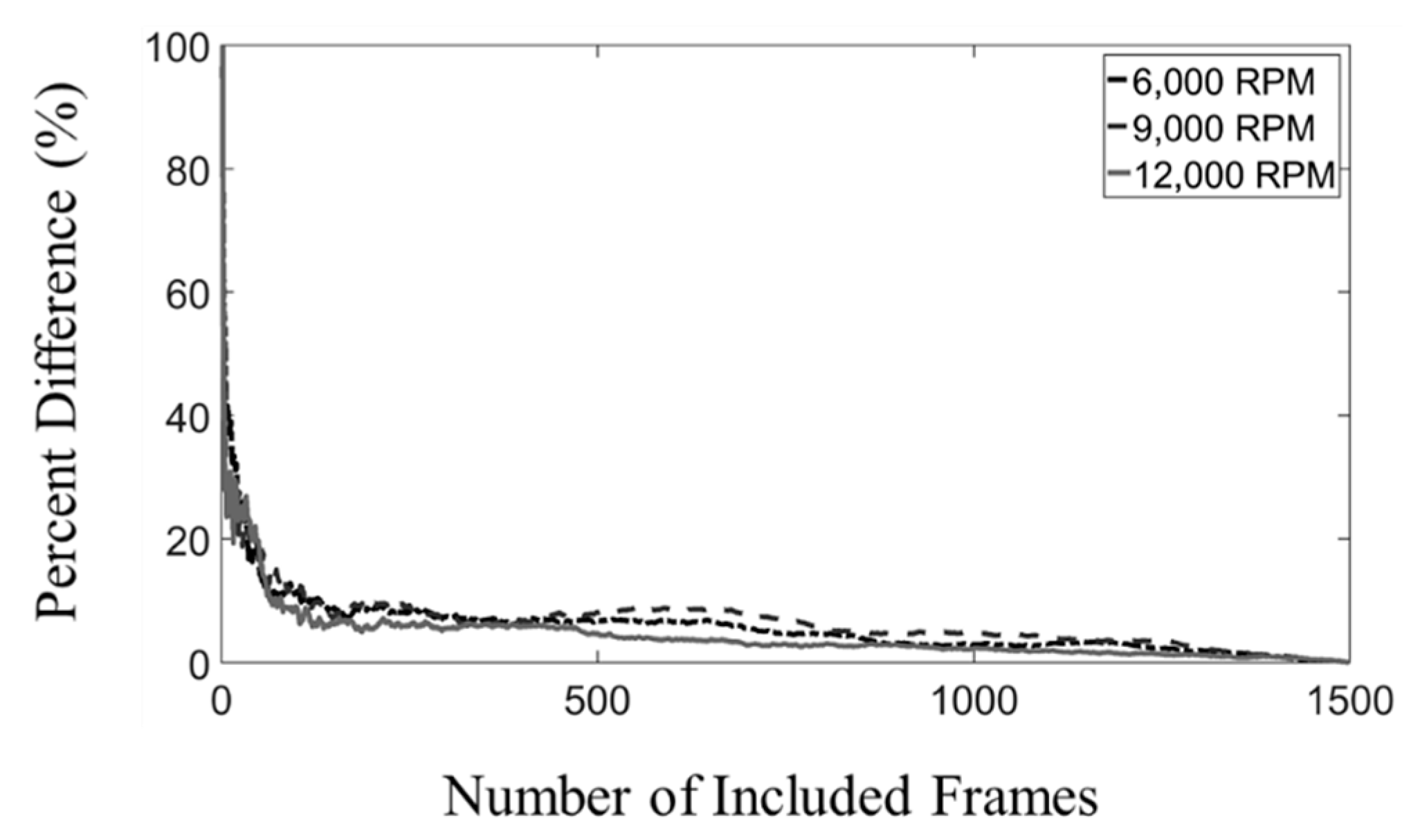
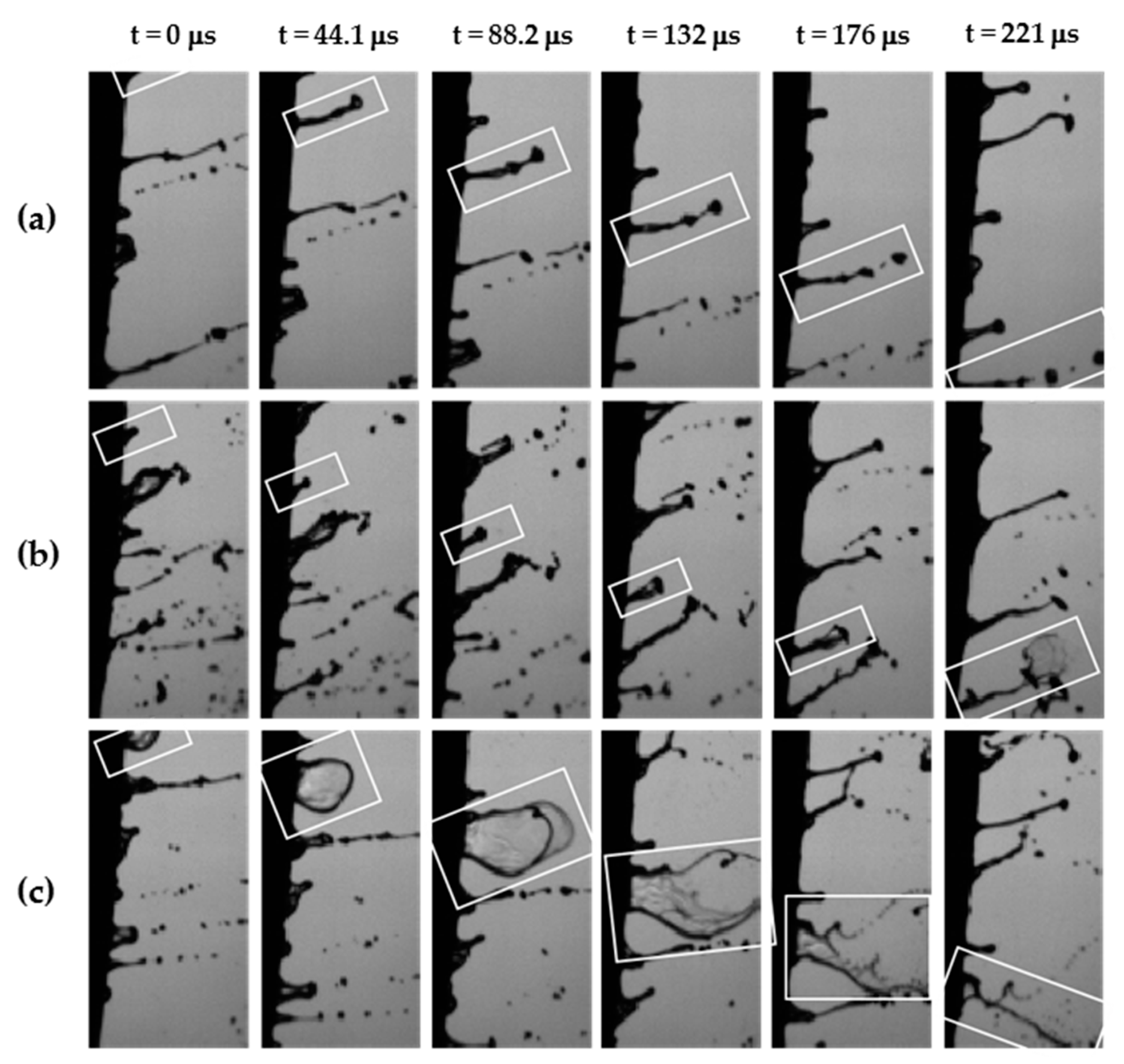

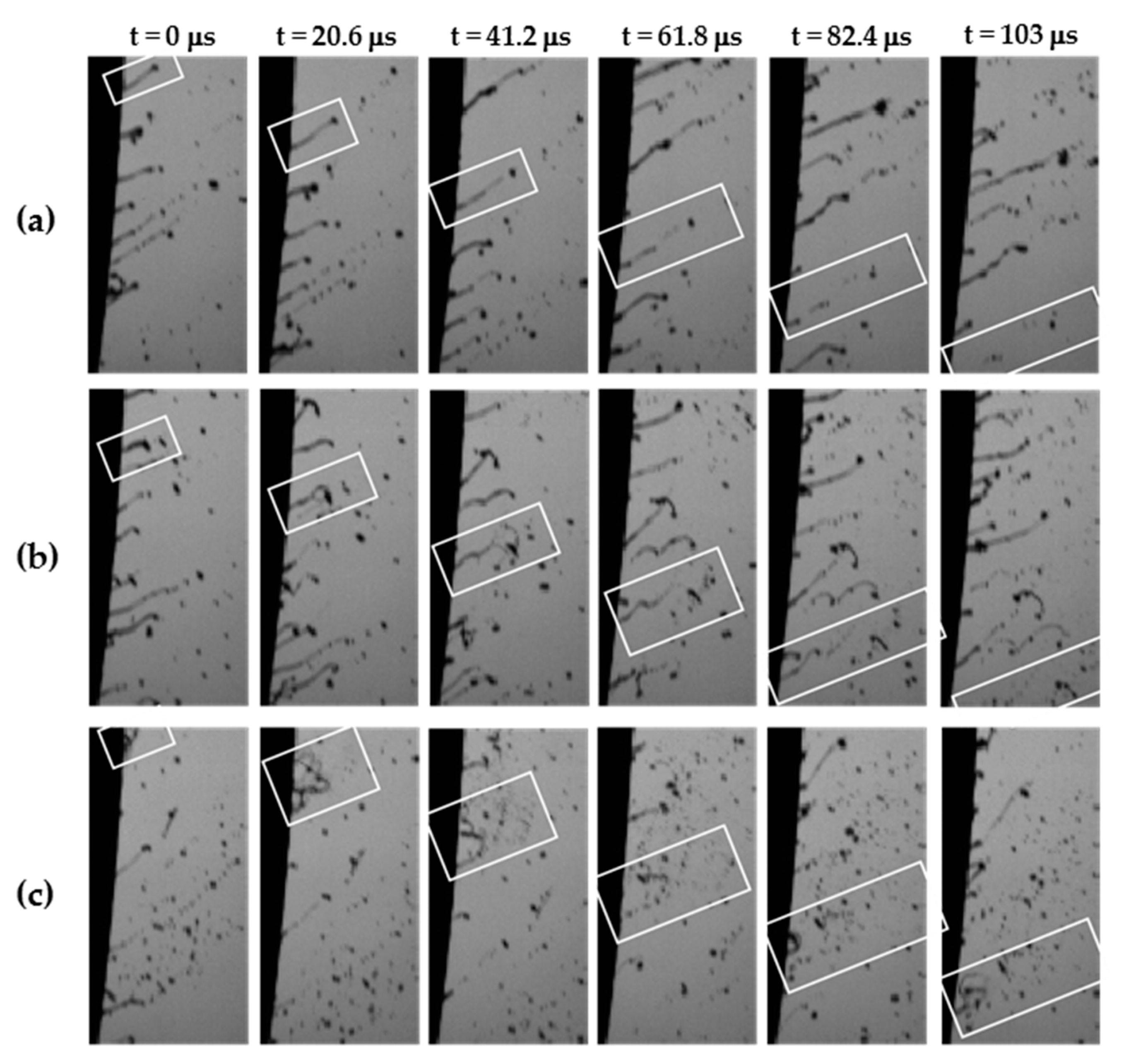



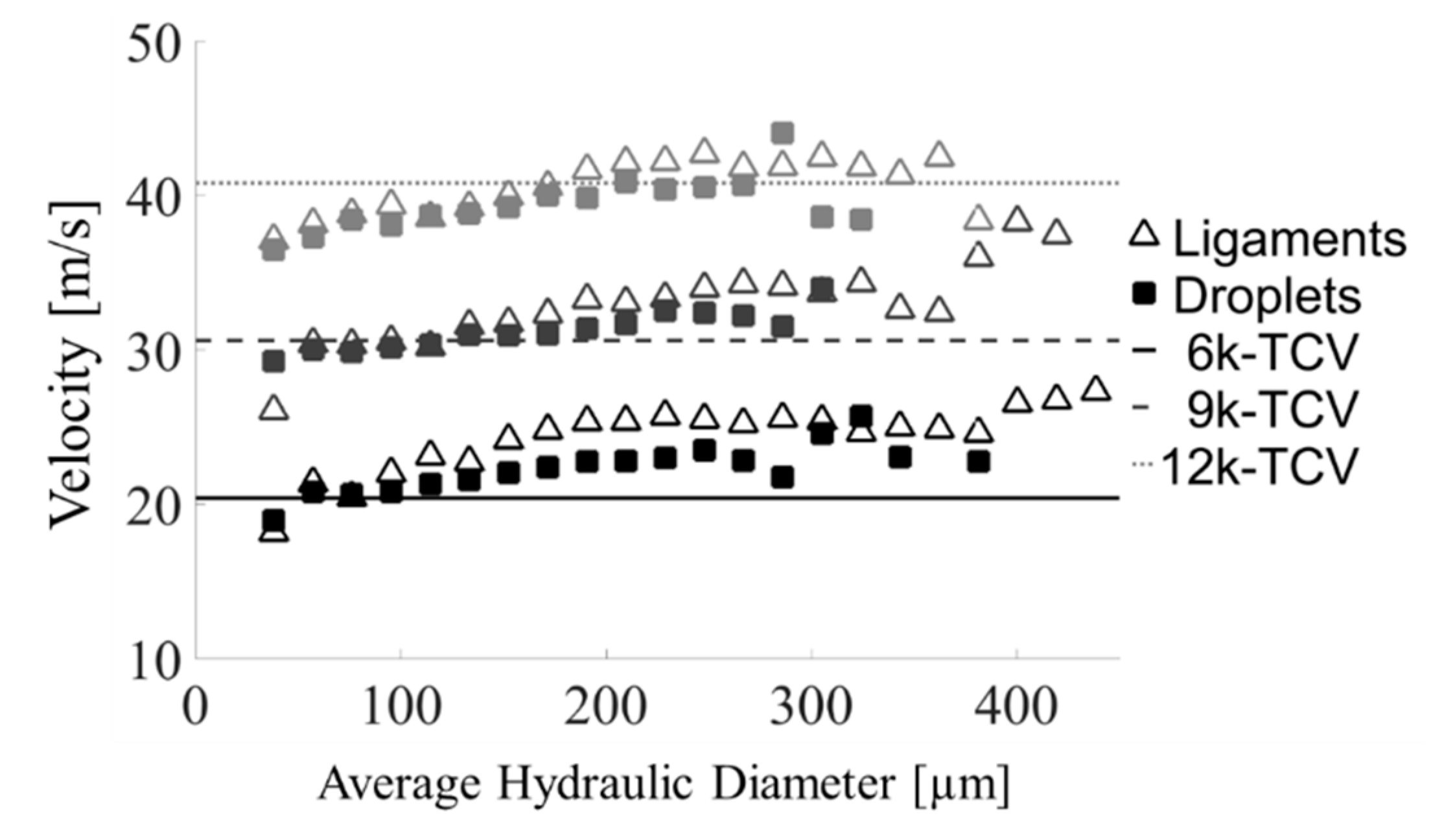
| Measured Quantities | Bell Speed [kRPM] | ||||||||
|---|---|---|---|---|---|---|---|---|---|
| 5 | 6 | 7 | 8 | 9 | 10 | 11 | 12 | ||
| Size | Ligaments | 31.8 | 48.9 | 33.3 | 5.87 | 56.5 | 25.3 | 23.9 | 32.1 |
| Droplets | 3.67 | 5.13 | 1.73 | 8.33 | 1.47 | 2.13 | 1.87 | 2.40 | |
| Combined | 3.87 | 7.40 | 5.67 | 8.00 | 4.07 | 3.13 | 1.87 | 2.53 | |
| Velocity | Ligaments | 25.9 | 21.6 | 22.6 | 38.0 | 45.8 | 44.9 | 35.1 | 47.4 |
| Droplets | 25.8 | 27.5 | 21.2 | 12.6 | 10.5 | 14.9 | 9.47 | 7.53 | |
| Combined | 17.4 | 17.1 | 14.9 | 6.07 | 7.80 | 13.0 | 5.13 | 6.60 | |
| Statistical Quantities | Bell Speed [kRPM] | ||||||||
|---|---|---|---|---|---|---|---|---|---|
| 5 | 6 | 7 | 8 | 9 | 10 | 11 | 12 | ||
| Span | Ligaments | 0.61 | 0.60 | 0.57 | 0.56 | 0.56 | 0.56 | 0.58 | 0.58 |
| Droplets | 0.84 | 0.86 | 0.90 | 0.93 | 0.87 | 0.94 | 0.95 | 0.99 | |
| Combined | 0.87 | 0.86 | 0.86 | 0.88 | 0.86 | 0.89 | 0.92 | 0.96 | |
| D32 [μm] | Ligaments | 274 | 252 | 234 | 223 | 221 | 209 | 205 | 201 |
| Droplets | 153 | 144 | 136 | 132 | 137 | 124 | 123 | 119 | |
| Combined | 228 | 207 | 187 | 175 | 175 | 159 | 153 | 146 | |
| Measured Quantities | Bell Speed [kRPM] | |||||||
|---|---|---|---|---|---|---|---|---|
| 5 | 6 | 7 | 8 | 9 | 10 | 11 | 12 | |
| Tangential Cup Speed [m/s] | ||||||||
| 17.0 | 20.4 | 23.8 | 27.2 | 30.6 | 34.0 | 37.4 | 40.8 | |
| Vavg—Total [m/s] | ||||||||
| Ligaments | 20.3 | 24.9 | 26.7 | 28.9 | 32.9 | 36.3 | 38.7 | 40.9 |
| Droplets | 18.5 | 21.7 | 24.8 | 27.3 | 30.8 | 32.9 | 35.6 | 37.9 |
| Combined | 19.0 | 22.5 | 25.2 | 27.6 | 31.2 | 33.4 | 36.0 | 38.2 |
| Vavg—Tangential [m/s] | ||||||||
| Ligaments | 16.9 | 21.5 | 25.2 | 27.1 | 30.0 | 33.7 | 36.6 | 38.5 |
| Droplets | 15.6 | 18.7 | 21.9 | 24.5 | 27.9 | 29.9 | 32.8 | 35.0 |
| Combined | 16.0 | 19.4 | 22.6 | 25.0 | 28.3 | 30.5 | 33.3 | 35.4 |
© 2018 by the authors. Licensee MDPI, Basel, Switzerland. This article is an open access article distributed under the terms and conditions of the Creative Commons Attribution (CC BY) license (http://creativecommons.org/licenses/by/4.0/).
Share and Cite
Wilson, J.E.; Grib, S.W.; Darwish Ahmad, A.; Renfro, M.W.; Adams, S.A.; Salaimeh, A.A. Study of Near-Cup Droplet Breakup of an Automotive Electrostatic Rotary Bell (ESRB) Atomizer Using High-Speed Shadowgraph Imaging. Coatings 2018, 8, 174. https://doi.org/10.3390/coatings8050174
Wilson JE, Grib SW, Darwish Ahmad A, Renfro MW, Adams SA, Salaimeh AA. Study of Near-Cup Droplet Breakup of an Automotive Electrostatic Rotary Bell (ESRB) Atomizer Using High-Speed Shadowgraph Imaging. Coatings. 2018; 8(5):174. https://doi.org/10.3390/coatings8050174
Chicago/Turabian StyleWilson, Jacob E., Stephen W. Grib, Adnan Darwish Ahmad, Michael W. Renfro, Scott A. Adams, and Ahmad A. Salaimeh. 2018. "Study of Near-Cup Droplet Breakup of an Automotive Electrostatic Rotary Bell (ESRB) Atomizer Using High-Speed Shadowgraph Imaging" Coatings 8, no. 5: 174. https://doi.org/10.3390/coatings8050174





